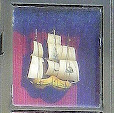The English Wikipedia article puts these two together under the name Daffodil or Narcissus (plural Narcissuses or Narcissi in BE, Narcissus in AE).
There are two derivations of the name Narcissus. One is that of a young man in Greek mythology who became so obsessed with his own reflection in a pool that he fell into the water and drowned. The Narcissus plant first sprang from where he died.
The other derivation is that the plant is named after its narcotic properties (ναρκάω narkao, "to grow numb" in Greek). All Narcissus varieties contain the alkaloid poison lycorine. The name Daffodil is derived from an earlier "Affodell", a variant of Asphodel. In Greek legend the asphodel is one of the most famous plants connected with the dead and the underworld.
In Swedish we have different names for these two Narcissi: We call the yellow one “påsklilja”, which means Easter Lily, and the white one “pingstlilja”, which means Pentecost Lily. (This will tell you that the yellow ones usually appear a bit earlier than the white ones, in our climate.) Because the yellow one is associated with Easter and early spring, it is also often used as a symbol of Life and Resurrection rather than Death. We do also use the name “narciss”, but most people associate that with the white one rather than with the yellow one.
Looking up them up in lists of Flower Language – in Swedish – I find these symbolic uses:
Yellow Narcissus (Påsklilja): “I can’t bear the thought of losing you.”
White Narcissus (Pingstlilja): “I love – but not you!”















2 comments:
As usual, I love your post! Another name we have for these is Jonquil. Our Easter lilies are white, and not daffodils. I had no idea about the poison, or asphodil, it fascinates me. I love learning word origions and the Greek myths!
I am with Ginny, in the south we call them jonquils. I love all the info and had no idea of any of that. i just thought they were pretty yellow flowers in my mothers garden. they were one of her most favorite flowers. I like the close up of the one with the red tinge around the edges. flowers are just plain wonderful.
Post a Comment